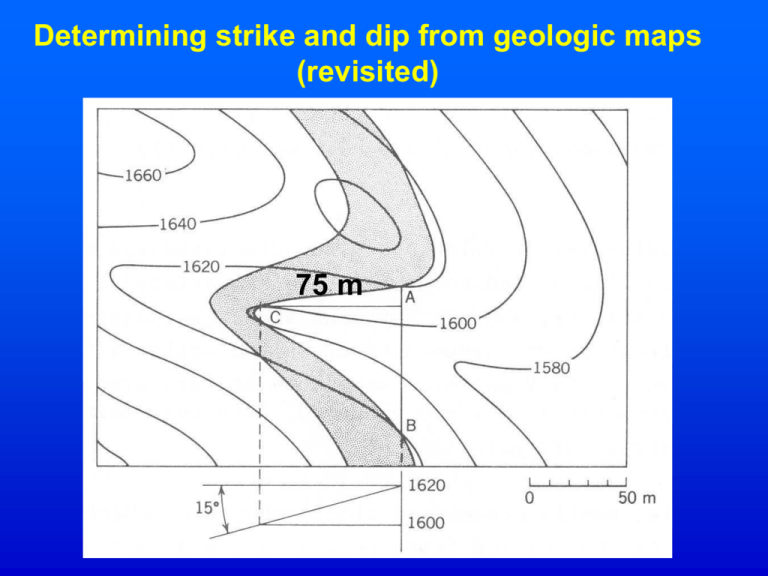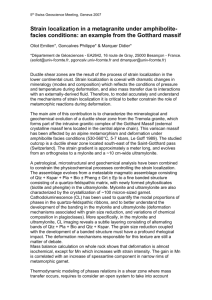Strain and the strain ellipsoid
advertisement

Determining strike and dip from geologic maps (revisited) 75 m This is a satellite photo of a plunging anticline ("A" shape) and syncline ("V" shape) pair. Which direction is the anticline plunging (to top or to bottom of figure)? Which direction is the syncline plunging toward? What is the name for these fold shapes? Are the apparent thicknesses of the beds less than or greater than the true thicknesses of the beds? What is it? (Quiz) (D&R 51-97) 1. Definitions and strain quantities 2. Mohr circle strain diagram 3. Pure shear vs. simple shear 4. Strain rate What is strain? Strain is dilation (change in size) and/or distortion (change in shape). The Goal of strain analysis is to explain how every line in a body changes in length and angle during deformation. How is this attempted? Homogeneous deformation: systematic and uniform. Test: straight lines in the body before deformation are straight after deformation. Circles get deformed into ellipses. We will assume that deformation is homogeneous! Heterogeneous deformation: irregular and non-uniform. A mess to work with, mathematically. Some important quantities for describing strain Extension (e): (Lf-Lo)/Lo, where Lf is the final length of a line and Lo is the initial length of a line Stretch (S): Lf/Lo, where 0 = severe shortening, 1 = no shortening, and infinity = severe stretching Quadratic elongation (l): = (1+e)2 = (Lf/Lo)2 = S2 Example of calculating extension (51.5 - 33)/33 = .56 = extension multiply by 100 to give you 56% extension A similar exercise can be performed for calculating %shortening in a thrust belt So far- we have only talked about changes in lengths of lines- what about angles? Angular shear (y, psi): degree to which 2 initially perpendicular lines are deflected from 90 degrees Shear strain (g, gamma): = tan (y) Finite vs. Instantaneous strain What does 'finite' mean? It is total strain, the final result of deformation that we see as geologists Instantaneous or infinitesimal strain describes a tiny increment of deformation As will become apparent when studying how fabrics form in rocks, the orientation of finite strain may be very different than that of instantaneous strain The "Magic" of homogeneous strain Strain ellipse and ellipsoid for homogeneous deformation: Shows how circular reference object is deformed 3-D 2-D Vs=4/3pr3 Ve=4/3pabc Calculating strain If the stretch values in the principal finite stretching directions are known, it is possible to determine the stretch and shear strain for any line of any orientation in the strained body. fundamental strain equations g/l (for any line of orientation qd from S1) = 1/2(1/l3-1/l1)sin2qd Strain can be calculated graphically in the Mohr Strain Circle: g/l = 1/2(1/l3-1/l1)sin2qd l'1 = 1/l1 l'3 = 1/l3 Some more definitions Plane strain: S1 is compensated by S3 so that there is no change in S2- and no change in volume! Noncoaxial strain: finite principal stretching axes do not remain fixed in orientation during deformation Coaxial strain: Finite principal stretching directions have the same orientation before and after deformation 2 end-member types of plane strain Simple shear: Rock is sheared like a deck of cards. A square becomes a parallelogram. **The finite stretching axes rotate during deformation. Distortion by simple shear is the most important process in shaping shear-zone structures! Pure shear: Rock is shortened in one direction and extended in the perpendicular direction. A square becomes a rectangle. **The finite stretching axes do not rotate. A better feeling for simple shear lines in circle brachiopod A better feeling for pure shear lines in circle brachiopod Strain Rate strain rate = extension (e) divided by time (t) = e/t The rate at which a rock is strained has important implications for the manner in which it deforms. "Lab" Strain Rates During 1 hour experiment, an initially 2.297 cm-long sample is shortened to 2.28 cm. What is the average strain rate during this experiment? "Natural" Strain Rates Basin and Range extension: present-day width = 600 km initial width = 300 km Extension occurred over ~20 m.y. What was the strain rate? How much does it differ from laboratory experiments? What are the implications? Next Lecture: Stress! Read D&R 98-122 Important terminology/concepts dilation distortion homogeneous vs. heterogeneous deformation extension- definition and calculation of stretch strain ellipse and ellipsoid- principle stretch directions finite strain vs. instantaneous strain Mohr strain diagram plane strain noncoaxial vs. coaxial strain simple shear pure shear strain rate- definition and calculation of






